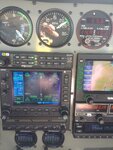dick56
Airman
In the northern Hemisphere the wind direction rotate clockwise from the ground up to about 55,000 feet. Above around 55,000 feet there is no wind.
When the SR-71 was cruising at 85,000 feet, they never worried what the wind was as there was none. From Area 51 after breakfast to Eglin Air Force base in Florida, it was 55 minutes and it was 55 minutes back to Area 51, but first you had to do a 258 mile radius turn over the Atlantic to turn around at Mach 3.2. Then you had to descend to around 28,000 feet to get enough fuel from a tanker to get back west and land in time for lunch. Quite a mornings work!
When the SR-71 was cruising at 85,000 feet, they never worried what the wind was as there was none. From Area 51 after breakfast to Eglin Air Force base in Florida, it was 55 minutes and it was 55 minutes back to Area 51, but first you had to do a 258 mile radius turn over the Atlantic to turn around at Mach 3.2. Then you had to descend to around 28,000 feet to get enough fuel from a tanker to get back west and land in time for lunch. Quite a mornings work!

